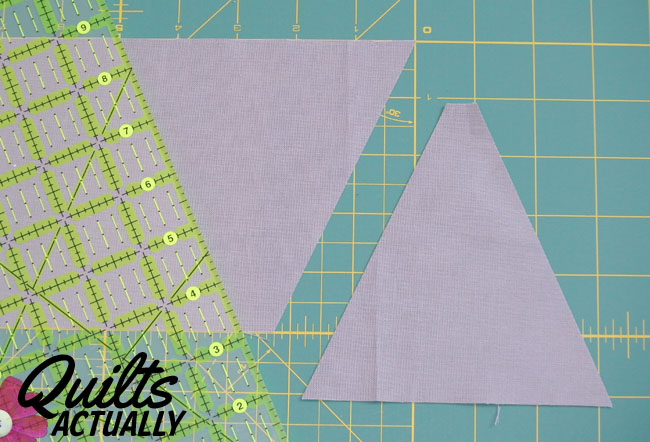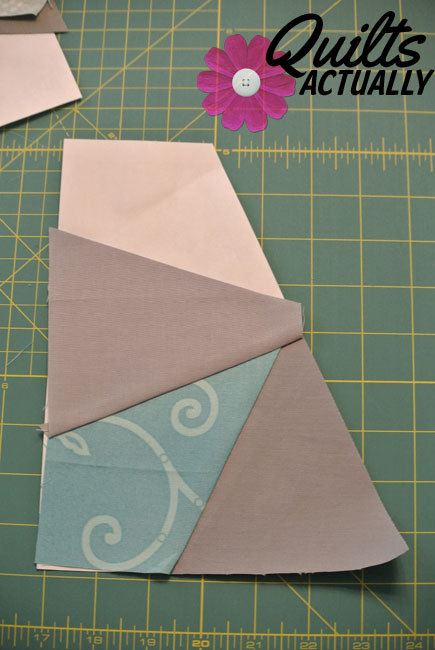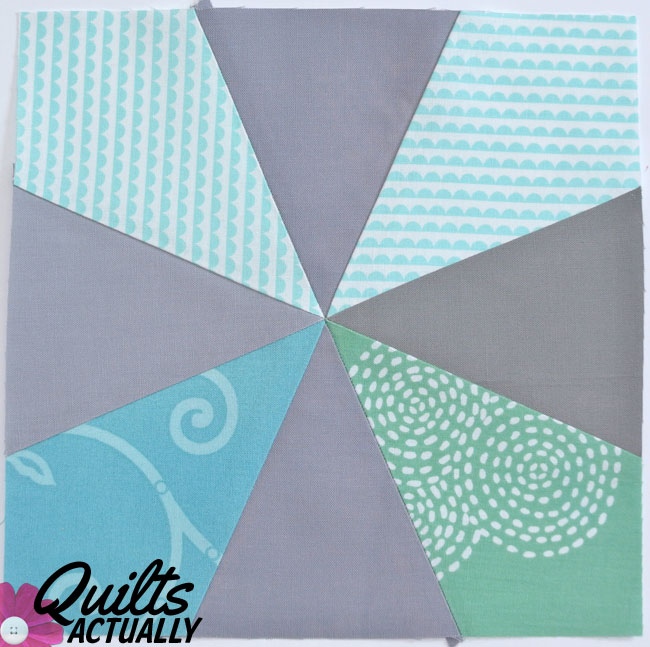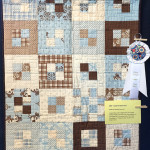If you are interested in learning and practicing paper piecing, the Square Dance Quilt Block is a great place to begin. This tutorial demonstrates basic paper piecing to create a block that by itself is not that special, but when combined to create a quilt, makes dynamic secondary designs. This is very doable for a beginner, or relaxing for someone with a little more experience.
History: When I was researching the history of this block, it was a little bit harder than I anticipated. It is so similar to the Kaleidoscope block that is very common, or even the tippecanoe block that is less common so I assumed it was a derivative of one of those. In fact, I considered calling it the Kaleidoscope remix for quite awhile. Then, I checked in the Encyclopedia of Pieced Quilt Patterns, and got schooled a little bit.
This block appears to have first appeared in print between 1825-1850 in a book of crib quilts. It goes by various names, including Square Dance, Starry Night, All around the star, Hummingbird, Dramatic Patch, and Rock Garden. Four of these blocks combined together is known as the Sacramento. I chose to use the Square Dance name because I think as you look at the completed quilt, it is the name that makes the most sense.
Supplies: Sewing Machine, Rotary Mat, Rotary Cutter, Quilting Ruler, Pins, Pattern, Washable Glue stick, Thread, Fabric
Pattern: The pattern is available for download from Craftsy for free during May 2014.
Cutting Instructions: These instructions are to make the paper piecing go faster, and make cutting the fabric from yardage easier. If you have a different method, or are using scraps, feel free to cut as desired. I will refer to the fabric for the rest of this tutorial by the colors I used in the sample block. Grey: For 1 block, cut a grey piece 13.25 inches by 5 inches. This has no waste, so if you like extra fabric cut it longer than 13.25 inches. Align the corner of your ruler with the bottom corner of the grey fabric. The top edge of the ruler needs to be 2.25 inches in from the top right corner.
The second cut will be as shown below. The top edge of the ruler needs to be 1/2 inch from the top right cut edge. The bottom of the ruler needs to be 5 inches from the bottom right cut edge.
Continue cutting using this method for as many grey triangles as you want to cut. The measurements remain the same, but alternate between the top and bottom edge as the long edge.
Aqua: For the aqua pieces, you can get two pieces from each 5 inch by 8 inch rectangle. Line the ruler up three inches from the top right edge and 5 inches from the bottom right edge.
Then cut…
When you finish cutting, for one block, you will have 4 grey triangles and 4 aqua trapezoids.
On to the paper piecing! Step one is to glue the first grey triangle into place. I use the washable school glue shown below, but use whatever you are familiar with.
Line up the aqua piece (right side down) with the grey piece.
Next, I fold the fabric over (using the printed sewing line as the guide) and hold it up to the light to make sure that it will cover the area.
This shows the opposite side of the above view.
After you check the positioning of the fabric, lay it back down and head to your sewing machine. First, reduce your stitch length. Or, if you are using a super old machine like me, you actually increase the number of stitches per inch. Just depends on the terminology your machine uses 🙂 Sew exactly on the black printed line.
Start sewing at the center intersection (where you can see thread sticking out), and sew until the outside light grey line. I personally like to chain piece these halves. It saves a lot of time to each step in a row, instead of individually. Then again, my sewing machine and iron are at opposite ends of the room so I get more exercise doing it separately.
This is what the two halves will look like after pressing.
Add another grey triangle. This is how the triangle should be aligned (shown as it looks when you hold it up to the light).
I folded the triangle over to double-check it fills up the area it needs to, and it does. I fold it back to the original position, and sew on the black line.
This is probably the first seam that needs to be trimmed. Fold the paper along the line you just sewed. You can use a scissors and approximate a 1/4 inch seam. I personally use the ruler and my rotary cutter to get the 1/4 seam.
This is what it looks like post-trim.
Press as before, and this is what your half will look like at this point.
Use the same methods demonstrated above to add the last aqua pieces. This is what the halves look like pre-trimming.
Trim along the grey lines printed on the pattern to get the below halves.
To get the center to match up, I place a pin through the exact center point of both halves.
Then, I proceed to pin the halves together. I don’t recommend using brand new pins for this part, as it can get thick and bend the pins.
As you sew the halves together, the center is thick and your machine may require a little assistance on the hand wheel. My Singer 201 can power through it, but my Janome 3160 has a tougher time with thick seams, so it depends on your machine. I like to remove the center paper before pressing the middle seam open.

Press the middle seam open.
Once the block is pressed open, remove the remainder of the paper. Remember two of the grey triangles were glued on, so take extra care to remove them without stretching the block. Once the paper is removed, I find starching paper pieced blocks really helps them keep their sharp shape.
Your completed block will look like this:
Once you combine these blocks, you can see the secondary patterns that begin to form. A completed quilt will look like the mockup below:
If you have any questions about this tutorial, please let me know. I would also love to see anything that you create using these blocks!
-Heather
Linking to: Anything Goes Monday, Let’s Bee Social Wednesday @ SewFreshQuilts, Needle and Thread Thursday @ My Quilt Infatuation, Whoop Whoop Fridays @ Confessions of a Quilt Addict, Fabric Frenzy Friday @ Ft. Worth Fabric, and Sewjo Saturday at My Go-Goo Life.








































Heading over to download this pattern – I love it! It’s the type of paper piecing I can do without too much stress. Your fabric choices are calling my name!
I hope you enjoy it! It’s probably pretty similar to what I assume you used for your one bee, but I think it’s a great way to practice paper piecing. The cutting method I demonstrate makes it a lot easier to properly place the pieces (which is what is still challenging to me – mostly when I try to skimp on fabric).
Your block design and fabric choices are fabulous, Heather. And your tutorial is so well done. Great pictures and such clear instructions. How generous of you to provide the pattern for free this month! I am sew sharing this on my facebook page!!!!
Thank you for sharing this on your Facebook page! I’m really glad your found the tutorial clear, it’s my first one that is this in depth.
What a great block and together they form such interesting patterns in the quilt top. I really like how you used multiple shades of grey for the background of the block – I’ve never thought of that but it really changes the way the whole top comes together!
I am also using this block for a bee, so I originally did the different shades of grey to account for the variations of fabric different people will have in their stash. I ended up really loving the effect!
YEE HAW! That is fantastic! Thank you for linking up to SEWjo Saturday!
Thanks for having such a fun link-up!
I have a friend that told me she wants to learn to paper piece. This is an excellent tutorial! I will share this with her. 🙂
Thanks for sharing! I really tried to make this pattern accessible to anyone – even if they have never paper pieced before. If she tries it, please let me know! I would love to see what she makes!
What an impressive quilt! I adore these calming sea colours!
Esther
Thank you! I hope the eventual recipient loves these colors as well 🙂
Heather, you did a fantastic job on the tutorial! I am going to have to try this out! Thank you for the inspiration–we have featured you over on the Fort Worth Fabric Studio blog! 🙂
-Lindsey
Thank you Lindsey! I appreciate you featuring my tutorial 🙂
Great block tutorial! I love the colors you used in the quilt- so calm and soothing!
Thank you so much for partying at Needle and Thread Thursday! I’d love for you to grab a button for your sidebar or add a text link back!
🙂 Kelly @ My Quilt Infatuation
It’s up now! Sorry about that, I got interrupted when I was adding my links and didn’t realize I didn’t finish updating the post. Thanks for your great link up!
Thanks for the tutorial. You are right about the pins bending I had that happen a few times with a similar block.
The pins are one of those lessons everyone ends up learning during paper piecing! And it always seems to happen when they are brand new 🙁 Thanks for stopping by!
Thank you for this excellent tutorial and pattern. I really love the secondary patterns that emerge with this block.
That is a lovely block!
Wonderful tutorial Heather. Going to download the pattern now and hope to try this block soon! Your fabric selections are perfect, beautiful quilt!